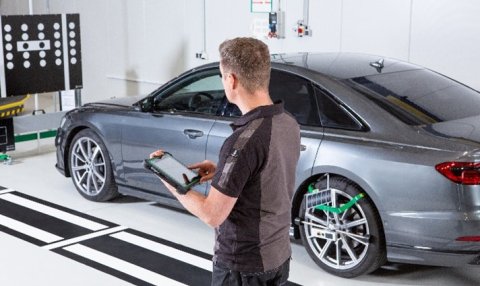What are the differences between wheel alignment and balancing? Our driver's guide
Wheel alignment and balancing are two important aspects of vehicle maintenance. Wheel alignment is the process of adjusting the angles of the wheels, so they are perpendicular to the ground and parallel to each other. Wheel balancing, on the other hand, is the process of equalizing the weight of the wheel and tyre assembly to ensure that it spins smoothly. Both processes help to maximize the life of your tyres and improve the performance of your vehicle.
Many drivers underestimate the impact of wheel alignment can make to the driving experience. In this guide, our aim is to show you the importance of perfect geometry on your car and the consequences of its absence.

What is car wheel alignment?
Wheel alignment (or tracking) is the process of adjusting the angles of the wheels of a vehicle to ensure they are perpendicular to the ground and parallel to each other. It is important for maximizing the life of the tyres, increasing fuel economy, and ensuring the vehicle runs safely and smoothly. Wheel alignment can be done by adjusting the camber, caster, and toe of the wheels. Let's see what are those three alignment settings.
What is toe angle?
Toe angle is the angle between the centre of the wheel and the centreline of the vehicle, when viewed from above. It is measured in degrees and is essential for wheel alignment and balancing. If the toe angle is incorrect, it can cause the vehicle to pull to one side and can lead to uneven tyre wear. Aligning toe angle is done by adjusting the angles of the wheels in relation to the axles of the vehicle. Proper toe angle alignment can help to improve the handling and performance of the vehicle as well as extending the life of the tyres. Properly aligned wheels also help to reduce wear and tear on the suspension system.
What is camber angle?
It is the angle of the wheel in relation to the vertical axis when viewed from the front or back of the vehicle. It is measured in degrees and generally ranges from negative 3 degrees to positive 3 degrees. Positive camber is when the top of the wheel is leaning outwards, while negative camber is when the top of the wheel is leaning inwards. The symptom of a badly adjusted camber is a significant wear on the inside or the outside of your tyre, depending on the positive or negative inclination of your wheel.
What is caster angle?
Caster angle is the angle between the steering axis and vertical, when viewed from the side of the vehicle. It is measured in degrees and has a direct effect on how the vehicle handles and corners. Positive caster angle improves the vehicle’s stability, while negative caster angle can cause instability and poor steering response. This setting defines the stability of your car at high speeds and improves your steering angles. Its natural disruption is rare, but it’s advisable to carry out a check after an accident in particular. The key symptom of a bad caster angle is a modified steering, either harder or with a lack of responsiveness depending on the disorder.
What is the difference between parallelism and geometry?
Many confuse or associate the notions of geometry and parallelism, wrongly. Indeed, parallelism involves ensuring the wheels are parallel to each other and perpendicular to the ground, while geometry involves making sure the wheels are at the correct camber and toe angles.
The key symptom of faulty parallelism is the smooth and uncontrolled shift of your vehicle to one side of the road when you are in a straight line.
When should you have a wheel tracking?
A small faulty adjustment can have a clear impact on your vehicle’s responsiveness, which is why it’s essential to always have perfect wheel alignment and for it to be regularly updated. Indeed, very slight external disturbances can disturb the camber and the parallelism of your wheels.
Therefore, always be sure to make your vehicle checked in the following situations:
- A traffic accident, even very slight, as an impact with a sidewalk
- Various driving anomalies
- Direction pulling to one side
- Abnormally stiff steering wheel after a turn
- Tyres that wear strangely quickly and irregularly
- When installing new tyres on a used car
All these points of vigilance are alerts of faulty wheel alignment and can disappear very quickly while increasing your driving comfort.
How does wheel alignment service work?
To adjust these items, your Point S experts will use 3D wheel alignment technology. The principle is as follows: callipers will be placed on each component of the vehicle running gear; a laser will then be sent to these callipers and reflected in order to calculate the various angles to the nearest tenth of a mm. After your expert gathered this information, he will only have to make the necessary adjustments to make your vehicle perfectly balanced to give it all the performance it can deliver and the comfort you deserve.
How much does a wheel alignment typically cost?
The price of a complete wheel alignment is relatively variable, it depends on the vehicle and the depth of the service that will be performed.
Overall, we can only advise you to invest in a regularly rebuilt geometry because it will allow you in a long term to make real savings in terms of fuel consumption and tyre wear. In addition, you will also benefit from a safer vehicle with better handling.
We recommend you check your wheel alignment at least once a year or as soon as you notice any of the symptoms mentioned in this article.
What is wheel balancing?
Wheel balancing is a process that ensures that the weight of a wheel and tyretyre assembly is evenly distributed. This process is important for ensuring that the tyres wear evenly, which helps to maximize performance and safety. The wheel balancing process involves the use of specialized equipment to measure the weight of the wheel and tyre assembly and then make adjustments to ensure that the weight is evenly distributed.
So, wheel balancing aims at distributing the masses evenly to make your car and tyres as balanced as possible. The main symptom of faulty balancing is wheel vibration, which can cause a quicker wear of your tyre bandwidth.
Remember to request a balancing of your wheel / tyre set each time you change your vehicle tyres to prolong the tyre life. Of course, as stated just above, if you feel vibrations while driving, contact a specialist as soon as possible so as not to damage your tyres too much.
How often should I balance my wheels?
The frequency of wheel balancing depends on the number of miles you drive and the type of roads you drive on. Generally, it is recommended to check wheel balancing every 6 months or 6,000 miles, whichever comes first.
Wheels balancing vs wheel alignment
Wheel alignment and balancing are two separate processes that are often confused with one another, both being important aspects of vehicle maintenance. Wheel alignment refers to adjusting the angles of the wheels so that they are perpendicular to the ground and parallel to each other. Wheel balancing, on the other hand, is the process of equalizing the weight distribution around the wheel so that it rotates smoothly.
Do I need wheel balancing with alignment?
While wheel alignment does not require wheel balancing, it is often recommended to do both services at the same time for optimal performance. Ask your Point S expert for more advice on wheel alignment and wheel balancing!
For more advice and information about wheel alignment, wheels and other automobile subjects please check our different articles and our geometry and parallelism service.
- Invisible heroes: Why camera calibration is essential after a windscreen replacement
- Driving safely: Are the lights really set correctly?
- Everything you need to know about changing oil in your car
- All you need to know about car air conditioning: our expert advice
- How to sanitize your car ?
- Can You Drive with a Cracked Windscreen?



